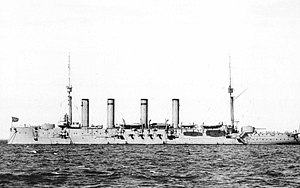Russian cruiser Pallada (1906)

| |
| History | |
|---|---|
| Name | Pallada |
| Builder | Admiralty Shipyard, Saint Petersburg, Russia |
| Laid down | August 1905 |
| Launched | 10 November 1906 |
| Commissioned | 21 February 1911 |
| Fate | Sunk by U-26 in the Gulf of Finland, 11 October 1914 |
| General characteristics | |
| Class and type | Bayan-class armored cruiser |
| Displacement | list error: <br /> list (help) 7,800 long tons (7,925 t) standard 8,340 long tons (8,474 t) max |
| Length | 135 m (443 ft) |
| Beam | 17.5 m (57 ft 5 in) |
| Draught | 6.7 m (22 ft) |
| Propulsion | list error: <br /> list (help) 2 shaft VTE steam engines 26 coal-fired boilers 16,500 shp (12,300 kW) |
| Speed | 21 knots (24 mph; 39 km/h) |
| Range | 3,900 nmi (7,200 km) at 10 kn (12 mph; 19 km/h) |
| Complement | 573 (597 at sinking) |
| Armament | list error: <br /> list (help) • 2 × 203 mm (8 in) guns • 8 × 152 mm (6 in) guns • 2 × 457 mm (18 in) torpedo tubes |
| Armour | list error: <br /> list (help) Krupp armor Belt: Up to 175 mm (6.9 in) Deck: Up to 30 mm (1.2 in) Turrets: 132 mm (5.2 in) Casemate: 60 mm (2.4 in) |
The Pallada was the last of the four Bayan-class armored cruisers in the Imperial Russian Navy. She was named after the earlier Russian cruiser captured by the Japanese during the Russo-Japanese war (1904-05) and saw service as part of the Russian Baltic Fleet in early stages of the World War I.
On August 26, 1914, Pallada, along with the cruiser Bogatyr, played critical role in capturing German naval codebooks from the light cruiser Magdeburg which ran aground near the island of Odensholm in the Gulf of Finland. The codebooks, transferred by the Russians to their British allies, proved to be an invaluable asset to British naval intelligence later in the war.
Less than two months later, on October 11, 1914, she was torpedoed by the German submarine U-26. The torpedo explosion detonated the ship's ammunition, and within a few minutes the cruiser disappeared into the water along with all 597 crew becoming the first Russian warship sunk during the war.
References
- Stephen McLaughlin, "From Ruirik to Ruirik: Russia's Armoured Cruisers", in Warship 1999-2000. Conway's Maritime Press
